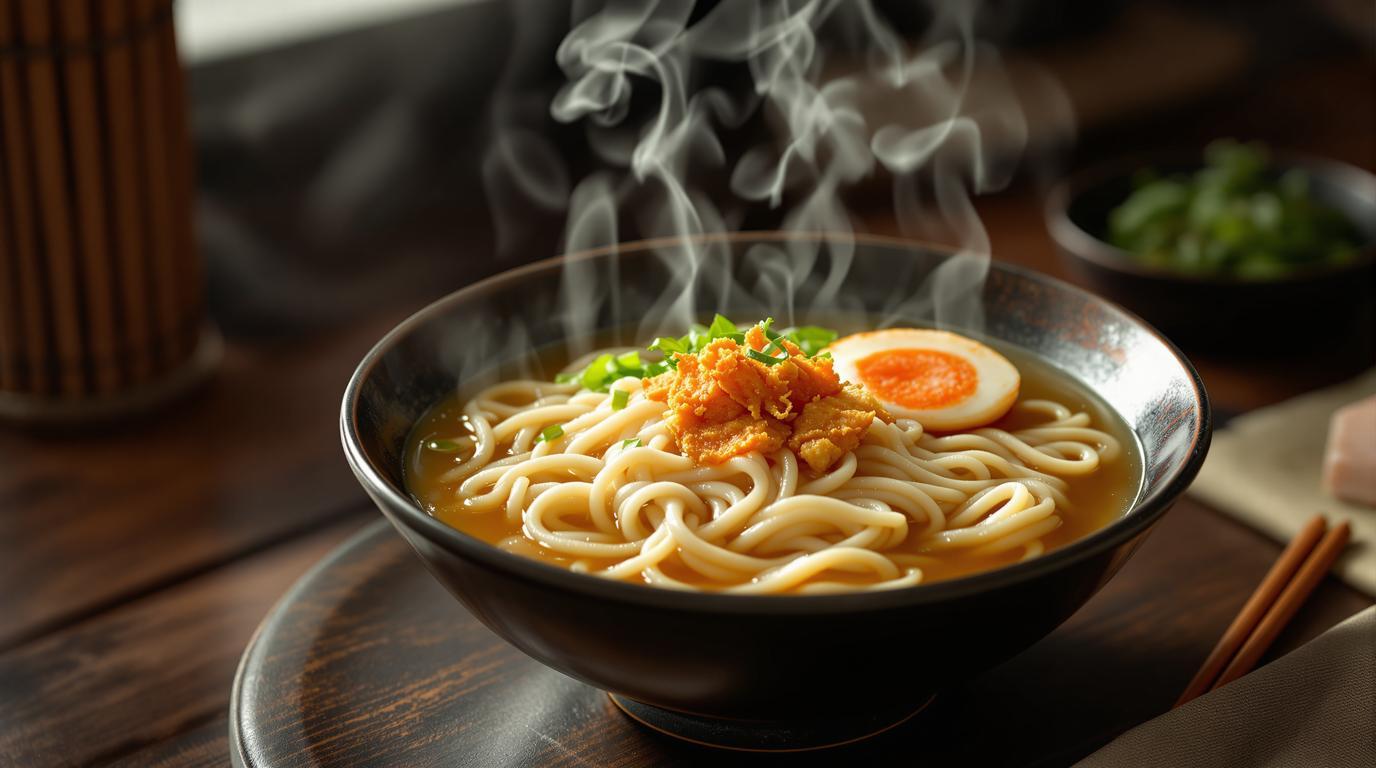The first time I tasted authentic Japanese udon in a tiny mountain restaurant outside Kyoto, I knew my culinary perspective had changed forever. There’s something almost magical about the contrast of chewy, substantial noodles against that crystal-clear dashi broth – a combination that’s both deeply comforting and remarkably sophisticated. After years of perfecting my technique, I’m excited to share this traditional hot udon recipe that honors centuries of Japanese culinary wisdom while fitting perfectly into our modern kitchens. The surprising depth of flavor from just a handful of ingredients still amazes me every time.
The Story 📖
Udon traces back to 12th century Japan, introduced by Buddhist monks as a hearty, sustaining dish. What fascinates me is how this seemingly simple noodle soup has developed distinct regional personalities across Japan – from the thick, chewy Sanuki udon of Kagawa Prefecture to the delicate Kitsune udon topped with sweet fried tofu. During my time staging at a traditional restaurant in Osaka, I learned that perfect udon isn’t about complexity but rather about honoring each element: the dashi, the noodles, and the carefully selected garnishes must work in perfect harmony.
Ingredients Spotlight 🧪
For 4 generous servings:
For the dashi broth:
- 8 cups (2 liters) cold water
- 2 pieces kombu seaweed (about 6 inches/15 cm each)
- 1½ cups (30g) katsuobushi (dried bonito flakes)
- ¼ cup (60ml) light soy sauce
- ¼ cup (60ml) mirin
- 1 teaspoon salt (adjust to taste)
For serving:
- 1½ pounds (680g) fresh or frozen udon noodles
- 4 green onions, thinly sliced diagonally
- Optional toppings: tempura scraps (tenkasu), kamaboko (fish cake), aburaage (fried tofu), soft-boiled egg
- Shichimi togarashi (seven-spice mixture) for serving
Step-by-Step Guide 📝
1. Prepare the dashi (25 minutes)
- Place kombu in cold water and let it steep for 20 minutes – this gentle infusion extracts maximum umami without bitterness
- Heat to just below boiling (about 175°F/80°C – look for tiny bubbles forming around the edges), then remove kombu
- Add katsuobushi, turn off heat immediately, and let steep for 10 minutes
- Strain through a fine-mesh sieve lined with cheesecloth, gently pressing (don’t squeeze) to extract flavor
- Return dashi to pot, add soy sauce and mirin, then bring to a gentle simmer
2. Cook the udon (5-7 minutes)
- Bring a large pot of unsalted water to a rolling boil (udon requires vigorous boiling)
- Cook noodles according to package directions, typically 5-7 minutes for fresh or 8-10 for dried
- Stir occasionally with chopsticks to prevent sticking
- Test by biting through a noodle – it should be tender but with a distinct chewiness (koshi)
- Drain and quickly rinse under cold water to remove surface starch, then drain thoroughly
3. Assemble and serve (2 minutes)
- Divide noodles between warmed bowls
- Ladle hot dashi over noodles (about 1½-2 cups per serving)
- Arrange toppings artfully on top
- Sprinkle with green onions and offer shichimi togarashi on the side
Expert Techniques 🛠️
The secret to exceptional udon lies in the dashi. Unlike Western stocks that benefit from long simmering, dashi requires precision timing to capture delicate flavors without extracting bitter compounds. I’ve learned to watch for the moment tiny bubbles appear around the kombu – this visual cue indicates the perfect extraction point before bitterness develops.
Chef’s Note: For an even more developed dashi, cold-steep your kombu overnight in the refrigerator before heating. This slower extraction captures subtle flavor compounds that hot water might destroy. It’s a technique I learned from a 70-year-old chef in Kyoto who insisted this was the only “honest way” to make proper dashi.
When cooking udon, the water should remain at a vigorous boil throughout – this helps develop the characteristic chewy texture (koshi) that distinguishes great udon. The cold-water rinse after cooking might seem counterintuitive for hot soup, but this crucial step prevents the noodles from becoming sticky while the residual heat within the thick noodles ensures they’ll still be hot when served.
Presentation & Pairing Ideas 🍽️
Traditional udon is best served in deep, wide bowls that allow the noodles to spread naturally in the broth. I like to arrange toppings in distinct sections rather than scattered throughout – this creates a more intentional presentation that invites diners to discover each element.
For wine pairings, I’ve found that a crisp Junmai sake works beautifully, its clean rice notes complementing the dashi without overwhelming it. If sake isn’t your preference, try a light, mineral-driven white wine like a dry Riesling or Grüner Veltliner.
Consider serving alongside crispy-bottom gyoza for a complete Japanese meal experience, or follow with a light dessert to cleanse the palate.
For a vegetarian version, replace the katsuobushi with 2 tablespoons of dried shiitake mushrooms during the dashi preparation. The resulting broth offers a different but equally complex umami foundation. In summer, try serving your udon chilled with a concentrated dipping sauce (tsukemen style) – it’s a refreshing alternative that showcases the noodles’ texture in a completely different light.
Remember, udon is ultimately about balance and restraint. Trust the inherent quality of your ingredients, treat them with respect, and you’ll create a dish that’s both humble and profound – the true essence of Japanese cuisine that I continue to find endlessly fascinating after all these years. Make it your own, but honor its soul.
